A Thematic Analysis of the Dynamic Tourism Environment
VerifiedAdded on 2023/06/10
|21
|3852
|308
AI Summary
This article discusses the impact of Covid-19 and other forces of change on the tourism industry. It evaluates current trends and identifies key forces of change in the industry. The article also discusses how tourism stakeholders respond to changes or events that impact upon the tourism industry.
Contribute Materials
Your contribution can guide someone’s learning journey. Share your
documents today.
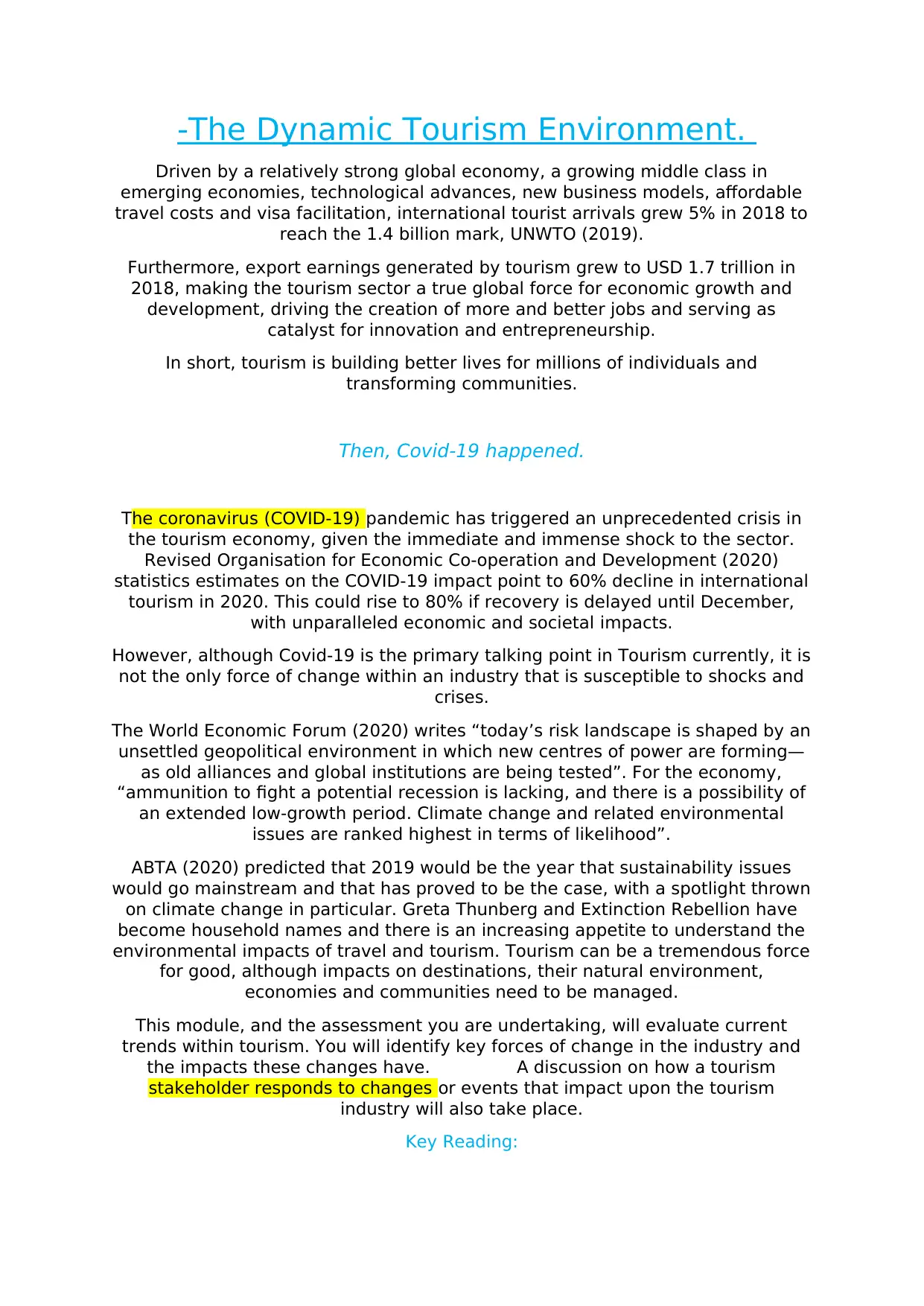
-The Dynamic Tourism Environment.
Driven by a relatively strong global economy, a growing middle class in
emerging economies, technological advances, new business models, affordable
travel costs and visa facilitation, international tourist arrivals grew 5% in 2018 to
reach the 1.4 billion mark, UNWTO (2019).
Furthermore, export earnings generated by tourism grew to USD 1.7 trillion in
2018, making the tourism sector a true global force for economic growth and
development, driving the creation of more and better jobs and serving as
catalyst for innovation and entrepreneurship.
In short, tourism is building better lives for millions of individuals and
transforming communities.
Then, Covid-19 happened.
The coronavirus (COVID-19) pandemic has triggered an unprecedented crisis in
the tourism economy, given the immediate and immense shock to the sector.
Revised Organisation for Economic Co-operation and Development (2020)
statistics estimates on the COVID-19 impact point to 60% decline in international
tourism in 2020. This could rise to 80% if recovery is delayed until December,
with unparalleled economic and societal impacts.
However, although Covid-19 is the primary talking point in Tourism currently, it is
not the only force of change within an industry that is susceptible to shocks and
crises.
The World Economic Forum (2020) writes “today’s risk landscape is shaped by an
unsettled geopolitical environment in which new centres of power are forming—
as old alliances and global institutions are being tested”. For the economy,
“ammunition to fight a potential recession is lacking, and there is a possibility of
an extended low-growth period. Climate change and related environmental
issues are ranked highest in terms of likelihood”.
ABTA (2020) predicted that 2019 would be the year that sustainability issues
would go mainstream and that has proved to be the case, with a spotlight thrown
on climate change in particular. Greta Thunberg and Extinction Rebellion have
become household names and there is an increasing appetite to understand the
environmental impacts of travel and tourism. Tourism can be a tremendous force
for good, although impacts on destinations, their natural environment,
economies and communities need to be managed.
This module, and the assessment you are undertaking, will evaluate current
trends within tourism. You will identify key forces of change in the industry and
the impacts these changes have. A discussion on how a tourism
stakeholder responds to changes or events that impact upon the tourism
industry will also take place.
Key Reading:
Driven by a relatively strong global economy, a growing middle class in
emerging economies, technological advances, new business models, affordable
travel costs and visa facilitation, international tourist arrivals grew 5% in 2018 to
reach the 1.4 billion mark, UNWTO (2019).
Furthermore, export earnings generated by tourism grew to USD 1.7 trillion in
2018, making the tourism sector a true global force for economic growth and
development, driving the creation of more and better jobs and serving as
catalyst for innovation and entrepreneurship.
In short, tourism is building better lives for millions of individuals and
transforming communities.
Then, Covid-19 happened.
The coronavirus (COVID-19) pandemic has triggered an unprecedented crisis in
the tourism economy, given the immediate and immense shock to the sector.
Revised Organisation for Economic Co-operation and Development (2020)
statistics estimates on the COVID-19 impact point to 60% decline in international
tourism in 2020. This could rise to 80% if recovery is delayed until December,
with unparalleled economic and societal impacts.
However, although Covid-19 is the primary talking point in Tourism currently, it is
not the only force of change within an industry that is susceptible to shocks and
crises.
The World Economic Forum (2020) writes “today’s risk landscape is shaped by an
unsettled geopolitical environment in which new centres of power are forming—
as old alliances and global institutions are being tested”. For the economy,
“ammunition to fight a potential recession is lacking, and there is a possibility of
an extended low-growth period. Climate change and related environmental
issues are ranked highest in terms of likelihood”.
ABTA (2020) predicted that 2019 would be the year that sustainability issues
would go mainstream and that has proved to be the case, with a spotlight thrown
on climate change in particular. Greta Thunberg and Extinction Rebellion have
become household names and there is an increasing appetite to understand the
environmental impacts of travel and tourism. Tourism can be a tremendous force
for good, although impacts on destinations, their natural environment,
economies and communities need to be managed.
This module, and the assessment you are undertaking, will evaluate current
trends within tourism. You will identify key forces of change in the industry and
the impacts these changes have. A discussion on how a tourism
stakeholder responds to changes or events that impact upon the tourism
industry will also take place.
Key Reading:
Secure Best Marks with AI Grader
Need help grading? Try our AI Grader for instant feedback on your assignments.
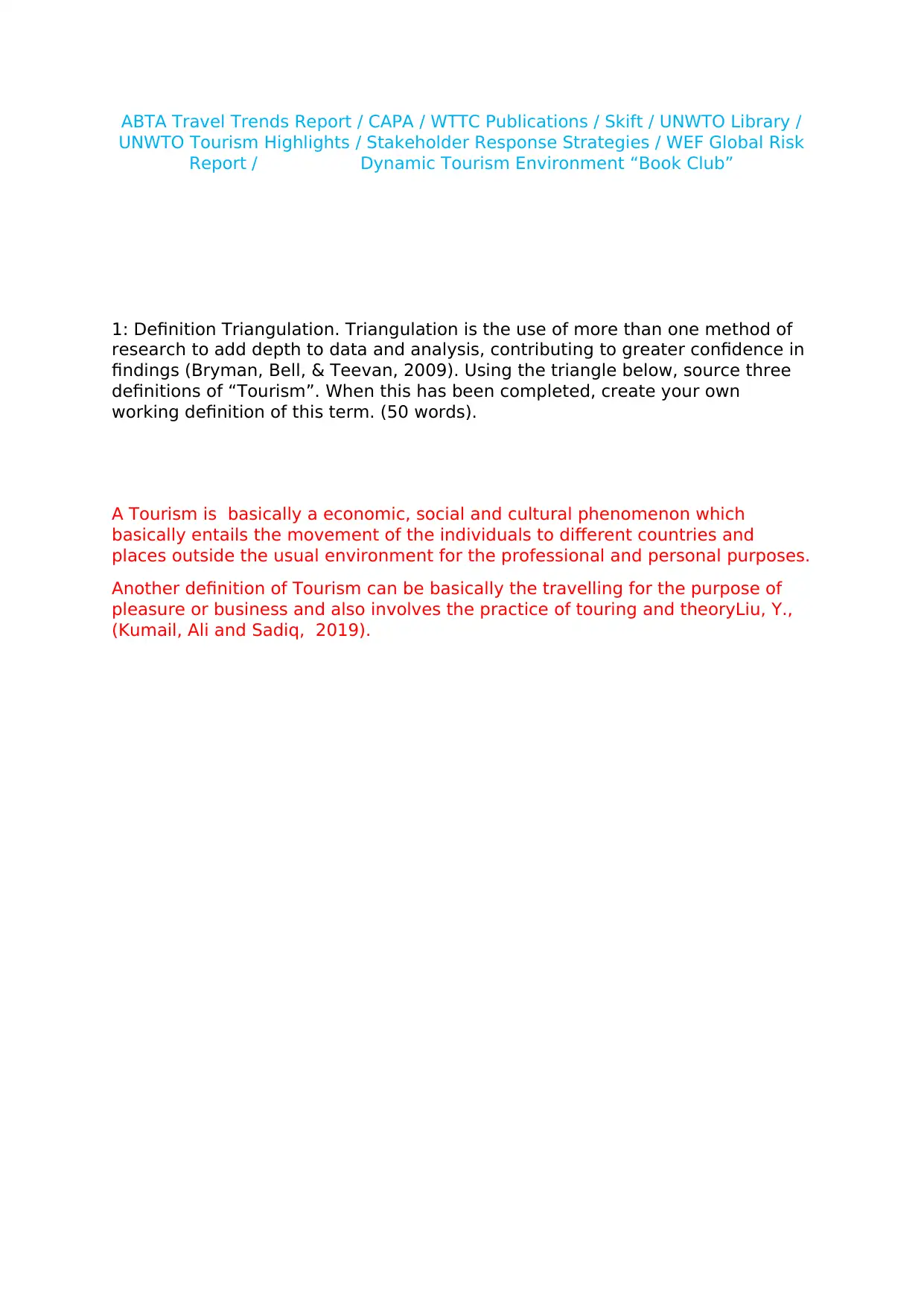
ABTA Travel Trends Report / CAPA / WTTC Publications / Skift / UNWTO Library /
UNWTO Tourism Highlights / Stakeholder Response Strategies / WEF Global Risk
Report / Dynamic Tourism Environment “Book Club”
1: Definition Triangulation. Triangulation is the use of more than one method of
research to add depth to data and analysis, contributing to greater confidence in
findings (Bryman, Bell, & Teevan, 2009). Using the triangle below, source three
definitions of “Tourism”. When this has been completed, create your own
working definition of this term. (50 words).
A Tourism is basically a economic, social and cultural phenomenon which
basically entails the movement of the individuals to different countries and
places outside the usual environment for the professional and personal purposes.
Another definition of Tourism can be basically the travelling for the purpose of
pleasure or business and also involves the practice of touring and theoryLiu, Y.,
(Kumail, Ali and Sadiq, 2019).
UNWTO Tourism Highlights / Stakeholder Response Strategies / WEF Global Risk
Report / Dynamic Tourism Environment “Book Club”
1: Definition Triangulation. Triangulation is the use of more than one method of
research to add depth to data and analysis, contributing to greater confidence in
findings (Bryman, Bell, & Teevan, 2009). Using the triangle below, source three
definitions of “Tourism”. When this has been completed, create your own
working definition of this term. (50 words).
A Tourism is basically a economic, social and cultural phenomenon which
basically entails the movement of the individuals to different countries and
places outside the usual environment for the professional and personal purposes.
Another definition of Tourism can be basically the travelling for the purpose of
pleasure or business and also involves the practice of touring and theoryLiu, Y.,
(Kumail, Ali and Sadiq, 2019).

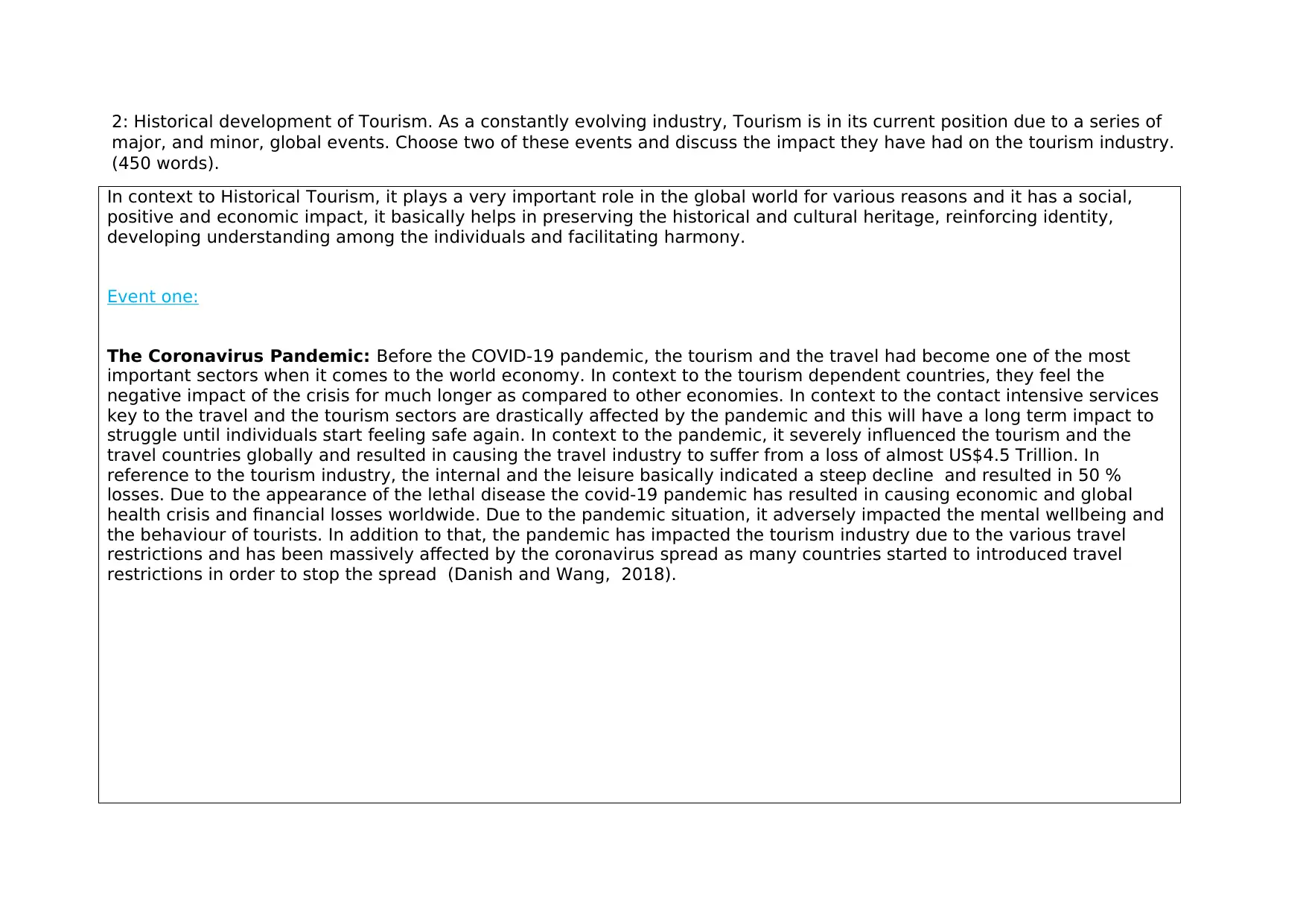
2: Historical development of Tourism. As a constantly evolving industry, Tourism is in its current position due to a series of
major, and minor, global events. Choose two of these events and discuss the impact they have had on the tourism industry.
(450 words).
In context to Historical Tourism, it plays a very important role in the global world for various reasons and it has a social,
positive and economic impact, it basically helps in preserving the historical and cultural heritage, reinforcing identity,
developing understanding among the individuals and facilitating harmony.
Event one:
The Coronavirus Pandemic: Before the COVID-19 pandemic, the tourism and the travel had become one of the most
important sectors when it comes to the world economy. In context to the tourism dependent countries, they feel the
negative impact of the crisis for much longer as compared to other economies. In context to the contact intensive services
key to the travel and the tourism sectors are drastically affected by the pandemic and this will have a long term impact to
struggle until individuals start feeling safe again. In context to the pandemic, it severely influenced the tourism and the
travel countries globally and resulted in causing the travel industry to suffer from a loss of almost US$4.5 Trillion. In
reference to the tourism industry, the internal and the leisure basically indicated a steep decline and resulted in 50 %
losses. Due to the appearance of the lethal disease the covid-19 pandemic has resulted in causing economic and global
health crisis and financial losses worldwide. Due to the pandemic situation, it adversely impacted the mental wellbeing and
the behaviour of tourists. In addition to that, the pandemic has impacted the tourism industry due to the various travel
restrictions and has been massively affected by the coronavirus spread as many countries started to introduced travel
restrictions in order to stop the spread (Danish and Wang, 2018).
major, and minor, global events. Choose two of these events and discuss the impact they have had on the tourism industry.
(450 words).
In context to Historical Tourism, it plays a very important role in the global world for various reasons and it has a social,
positive and economic impact, it basically helps in preserving the historical and cultural heritage, reinforcing identity,
developing understanding among the individuals and facilitating harmony.
Event one:
The Coronavirus Pandemic: Before the COVID-19 pandemic, the tourism and the travel had become one of the most
important sectors when it comes to the world economy. In context to the tourism dependent countries, they feel the
negative impact of the crisis for much longer as compared to other economies. In context to the contact intensive services
key to the travel and the tourism sectors are drastically affected by the pandemic and this will have a long term impact to
struggle until individuals start feeling safe again. In context to the pandemic, it severely influenced the tourism and the
travel countries globally and resulted in causing the travel industry to suffer from a loss of almost US$4.5 Trillion. In
reference to the tourism industry, the internal and the leisure basically indicated a steep decline and resulted in 50 %
losses. Due to the appearance of the lethal disease the covid-19 pandemic has resulted in causing economic and global
health crisis and financial losses worldwide. Due to the pandemic situation, it adversely impacted the mental wellbeing and
the behaviour of tourists. In addition to that, the pandemic has impacted the tourism industry due to the various travel
restrictions and has been massively affected by the coronavirus spread as many countries started to introduced travel
restrictions in order to stop the spread (Danish and Wang, 2018).
Secure Best Marks with AI Grader
Need help grading? Try our AI Grader for instant feedback on your assignments.
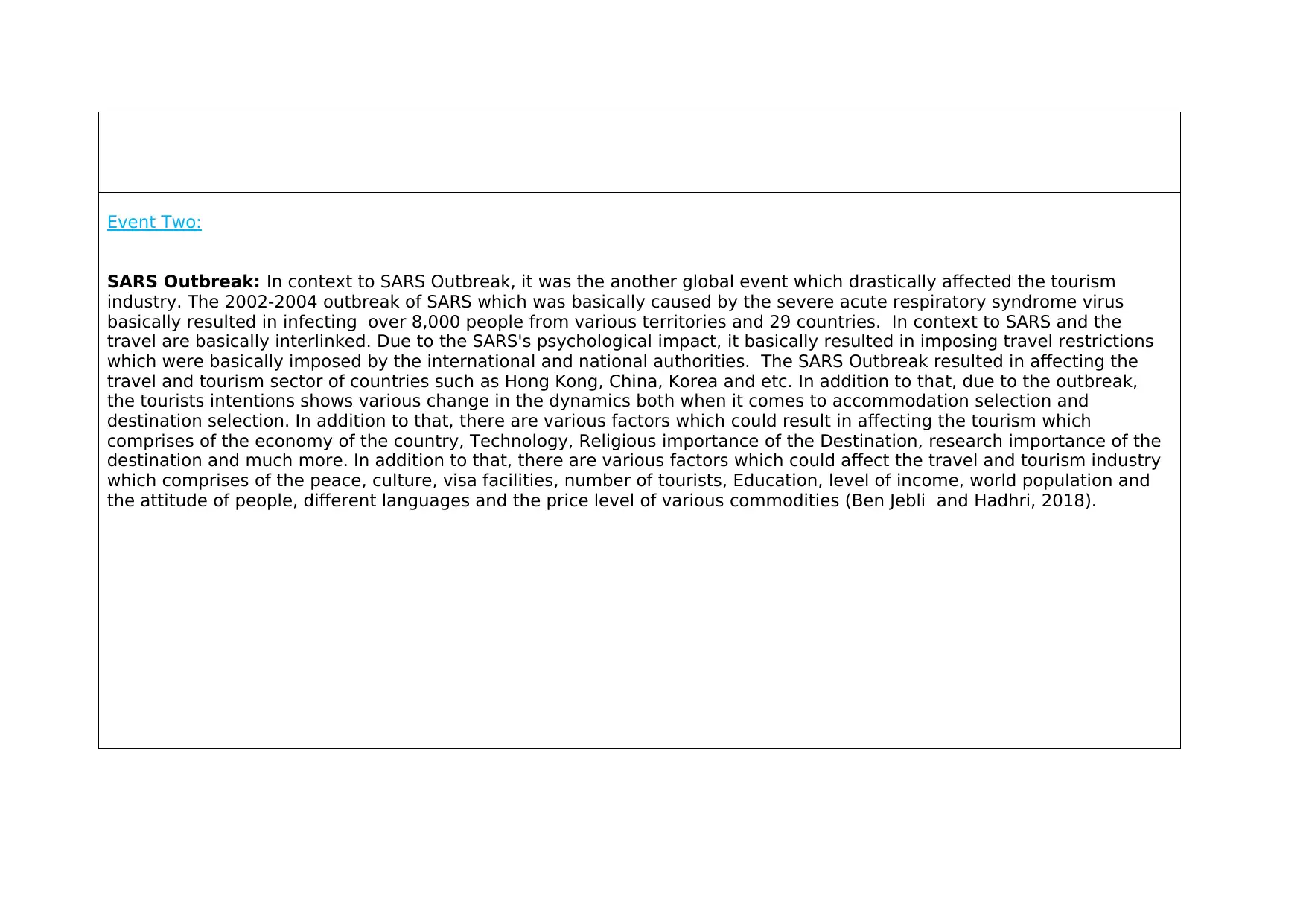
Event Two:
SARS Outbreak: In context to SARS Outbreak, it was the another global event which drastically affected the tourism
industry. The 2002-2004 outbreak of SARS which was basically caused by the severe acute respiratory syndrome virus
basically resulted in infecting over 8,000 people from various territories and 29 countries. In context to SARS and the
travel are basically interlinked. Due to the SARS's psychological impact, it basically resulted in imposing travel restrictions
which were basically imposed by the international and national authorities. The SARS Outbreak resulted in affecting the
travel and tourism sector of countries such as Hong Kong, China, Korea and etc. In addition to that, due to the outbreak,
the tourists intentions shows various change in the dynamics both when it comes to accommodation selection and
destination selection. In addition to that, there are various factors which could result in affecting the tourism which
comprises of the economy of the country, Technology, Religious importance of the Destination, research importance of the
destination and much more. In addition to that, there are various factors which could affect the travel and tourism industry
which comprises of the peace, culture, visa facilities, number of tourists, Education, level of income, world population and
the attitude of people, different languages and the price level of various commodities (Ben Jebli and Hadhri, 2018).
SARS Outbreak: In context to SARS Outbreak, it was the another global event which drastically affected the tourism
industry. The 2002-2004 outbreak of SARS which was basically caused by the severe acute respiratory syndrome virus
basically resulted in infecting over 8,000 people from various territories and 29 countries. In context to SARS and the
travel are basically interlinked. Due to the SARS's psychological impact, it basically resulted in imposing travel restrictions
which were basically imposed by the international and national authorities. The SARS Outbreak resulted in affecting the
travel and tourism sector of countries such as Hong Kong, China, Korea and etc. In addition to that, due to the outbreak,
the tourists intentions shows various change in the dynamics both when it comes to accommodation selection and
destination selection. In addition to that, there are various factors which could result in affecting the tourism which
comprises of the economy of the country, Technology, Religious importance of the Destination, research importance of the
destination and much more. In addition to that, there are various factors which could affect the travel and tourism industry
which comprises of the peace, culture, visa facilities, number of tourists, Education, level of income, world population and
the attitude of people, different languages and the price level of various commodities (Ben Jebli and Hadhri, 2018).
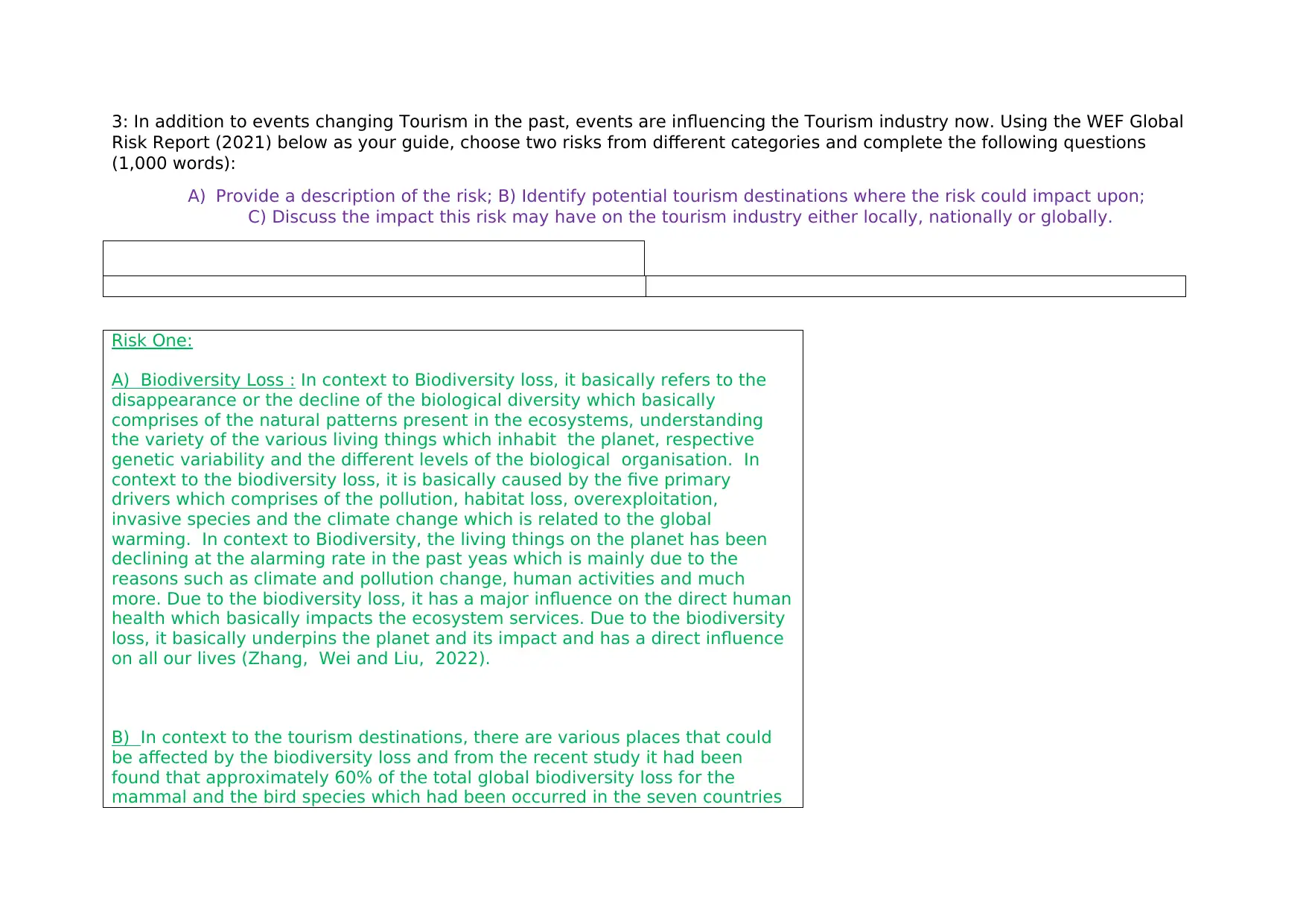
3: In addition to events changing Tourism in the past, events are influencing the Tourism industry now. Using the WEF Global
Risk Report (2021) below as your guide, choose two risks from different categories and complete the following questions
(1,000 words):
A) Provide a description of the risk; B) Identify potential tourism destinations where the risk could impact upon;
C) Discuss the impact this risk may have on the tourism industry either locally, nationally or globally.
Risk One:
A) Biodiversity Loss : In context to Biodiversity loss, it basically refers to the
disappearance or the decline of the biological diversity which basically
comprises of the natural patterns present in the ecosystems, understanding
the variety of the various living things which inhabit the planet, respective
genetic variability and the different levels of the biological organisation. In
context to the biodiversity loss, it is basically caused by the five primary
drivers which comprises of the pollution, habitat loss, overexploitation,
invasive species and the climate change which is related to the global
warming. In context to Biodiversity, the living things on the planet has been
declining at the alarming rate in the past yeas which is mainly due to the
reasons such as climate and pollution change, human activities and much
more. Due to the biodiversity loss, it has a major influence on the direct human
health which basically impacts the ecosystem services. Due to the biodiversity
loss, it basically underpins the planet and its impact and has a direct influence
on all our lives (Zhang, Wei and Liu, 2022).
B) In context to the tourism destinations, there are various places that could
be affected by the biodiversity loss and from the recent study it had been
found that approximately 60% of the total global biodiversity loss for the
mammal and the bird species which had been occurred in the seven countries
Risk Report (2021) below as your guide, choose two risks from different categories and complete the following questions
(1,000 words):
A) Provide a description of the risk; B) Identify potential tourism destinations where the risk could impact upon;
C) Discuss the impact this risk may have on the tourism industry either locally, nationally or globally.
Risk One:
A) Biodiversity Loss : In context to Biodiversity loss, it basically refers to the
disappearance or the decline of the biological diversity which basically
comprises of the natural patterns present in the ecosystems, understanding
the variety of the various living things which inhabit the planet, respective
genetic variability and the different levels of the biological organisation. In
context to the biodiversity loss, it is basically caused by the five primary
drivers which comprises of the pollution, habitat loss, overexploitation,
invasive species and the climate change which is related to the global
warming. In context to Biodiversity, the living things on the planet has been
declining at the alarming rate in the past yeas which is mainly due to the
reasons such as climate and pollution change, human activities and much
more. Due to the biodiversity loss, it has a major influence on the direct human
health which basically impacts the ecosystem services. Due to the biodiversity
loss, it basically underpins the planet and its impact and has a direct influence
on all our lives (Zhang, Wei and Liu, 2022).
B) In context to the tourism destinations, there are various places that could
be affected by the biodiversity loss and from the recent study it had been
found that approximately 60% of the total global biodiversity loss for the
mammal and the bird species which had been occurred in the seven countries
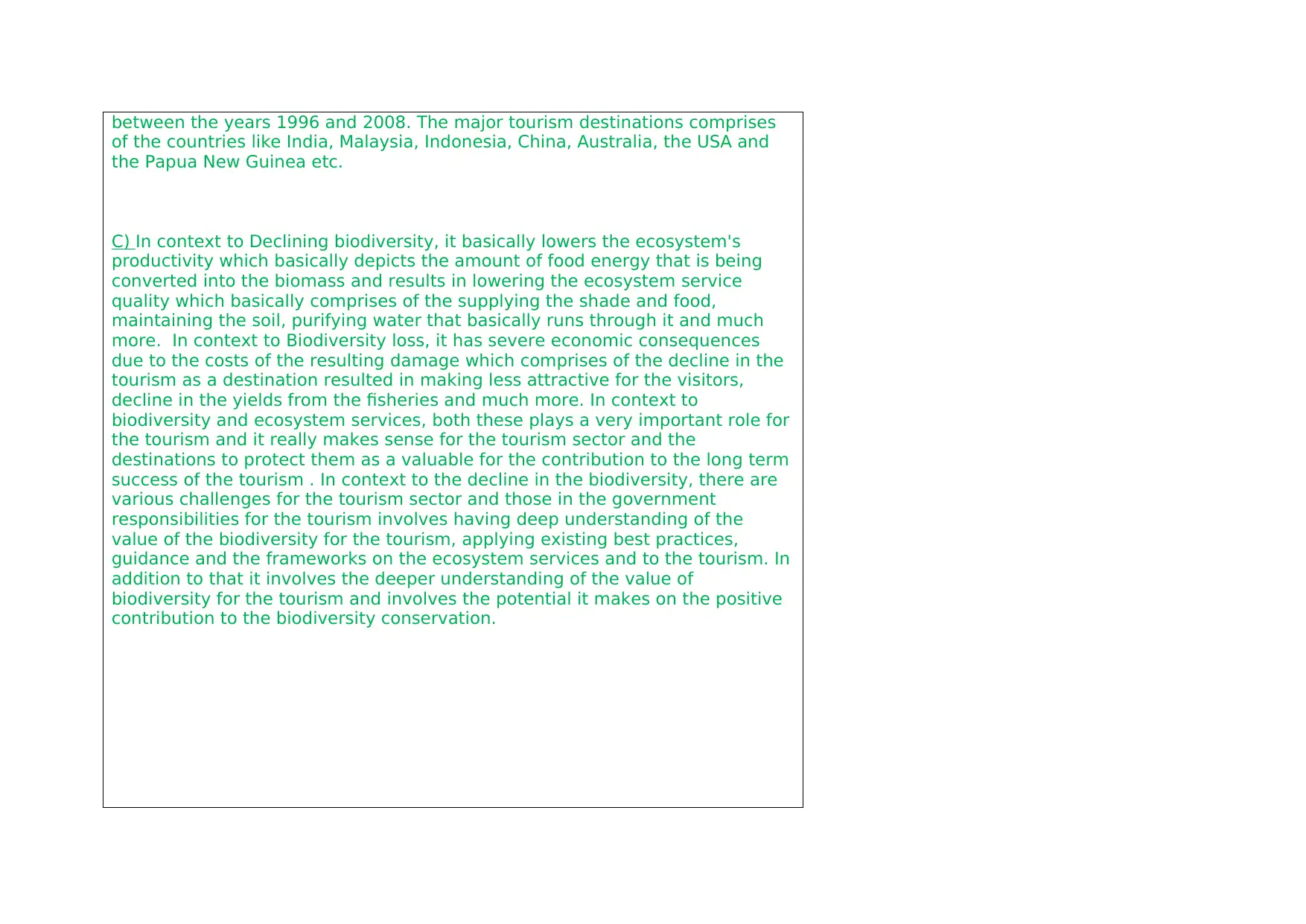
between the years 1996 and 2008. The major tourism destinations comprises
of the countries like India, Malaysia, Indonesia, China, Australia, the USA and
the Papua New Guinea etc.
C) In context to Declining biodiversity, it basically lowers the ecosystem's
productivity which basically depicts the amount of food energy that is being
converted into the biomass and results in lowering the ecosystem service
quality which basically comprises of the supplying the shade and food,
maintaining the soil, purifying water that basically runs through it and much
more. In context to Biodiversity loss, it has severe economic consequences
due to the costs of the resulting damage which comprises of the decline in the
tourism as a destination resulted in making less attractive for the visitors,
decline in the yields from the fisheries and much more. In context to
biodiversity and ecosystem services, both these plays a very important role for
the tourism and it really makes sense for the tourism sector and the
destinations to protect them as a valuable for the contribution to the long term
success of the tourism . In context to the decline in the biodiversity, there are
various challenges for the tourism sector and those in the government
responsibilities for the tourism involves having deep understanding of the
value of the biodiversity for the tourism, applying existing best practices,
guidance and the frameworks on the ecosystem services and to the tourism. In
addition to that it involves the deeper understanding of the value of
biodiversity for the tourism and involves the potential it makes on the positive
contribution to the biodiversity conservation.
of the countries like India, Malaysia, Indonesia, China, Australia, the USA and
the Papua New Guinea etc.
C) In context to Declining biodiversity, it basically lowers the ecosystem's
productivity which basically depicts the amount of food energy that is being
converted into the biomass and results in lowering the ecosystem service
quality which basically comprises of the supplying the shade and food,
maintaining the soil, purifying water that basically runs through it and much
more. In context to Biodiversity loss, it has severe economic consequences
due to the costs of the resulting damage which comprises of the decline in the
tourism as a destination resulted in making less attractive for the visitors,
decline in the yields from the fisheries and much more. In context to
biodiversity and ecosystem services, both these plays a very important role for
the tourism and it really makes sense for the tourism sector and the
destinations to protect them as a valuable for the contribution to the long term
success of the tourism . In context to the decline in the biodiversity, there are
various challenges for the tourism sector and those in the government
responsibilities for the tourism involves having deep understanding of the
value of the biodiversity for the tourism, applying existing best practices,
guidance and the frameworks on the ecosystem services and to the tourism. In
addition to that it involves the deeper understanding of the value of
biodiversity for the tourism and involves the potential it makes on the positive
contribution to the biodiversity conservation.
Paraphrase This Document
Need a fresh take? Get an instant paraphrase of this document with our AI Paraphraser
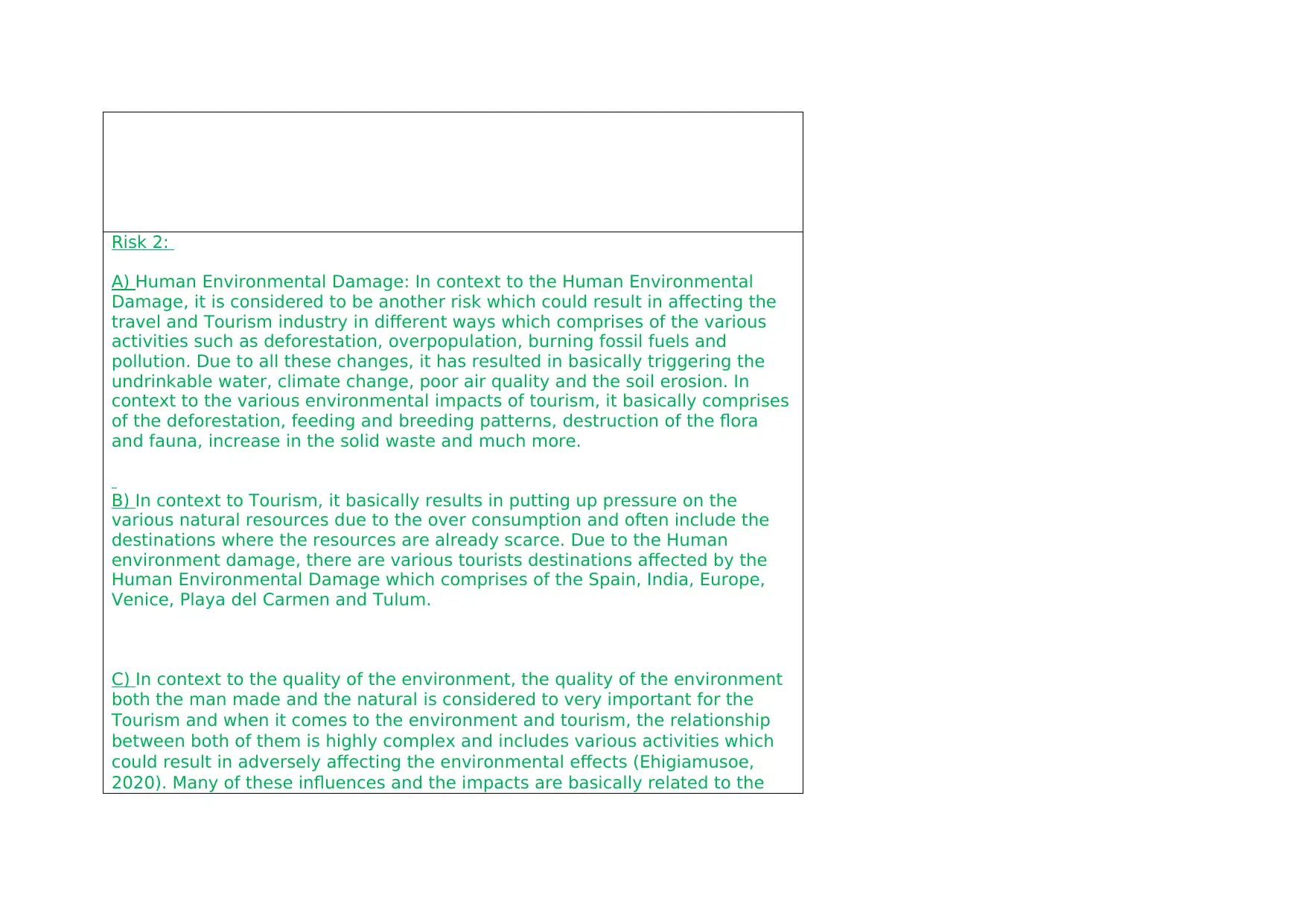
Risk 2:
A) Human Environmental Damage: In context to the Human Environmental
Damage, it is considered to be another risk which could result in affecting the
travel and Tourism industry in different ways which comprises of the various
activities such as deforestation, overpopulation, burning fossil fuels and
pollution. Due to all these changes, it has resulted in basically triggering the
undrinkable water, climate change, poor air quality and the soil erosion. In
context to the various environmental impacts of tourism, it basically comprises
of the deforestation, feeding and breeding patterns, destruction of the flora
and fauna, increase in the solid waste and much more.
B) In context to Tourism, it basically results in putting up pressure on the
various natural resources due to the over consumption and often include the
destinations where the resources are already scarce. Due to the Human
environment damage, there are various tourists destinations affected by the
Human Environmental Damage which comprises of the Spain, India, Europe,
Venice, Playa del Carmen and Tulum.
C) In context to the quality of the environment, the quality of the environment
both the man made and the natural is considered to very important for the
Tourism and when it comes to the environment and tourism, the relationship
between both of them is highly complex and includes various activities which
could result in adversely affecting the environmental effects (Ehigiamusoe,
2020). Many of these influences and the impacts are basically related to the
A) Human Environmental Damage: In context to the Human Environmental
Damage, it is considered to be another risk which could result in affecting the
travel and Tourism industry in different ways which comprises of the various
activities such as deforestation, overpopulation, burning fossil fuels and
pollution. Due to all these changes, it has resulted in basically triggering the
undrinkable water, climate change, poor air quality and the soil erosion. In
context to the various environmental impacts of tourism, it basically comprises
of the deforestation, feeding and breeding patterns, destruction of the flora
and fauna, increase in the solid waste and much more.
B) In context to Tourism, it basically results in putting up pressure on the
various natural resources due to the over consumption and often include the
destinations where the resources are already scarce. Due to the Human
environment damage, there are various tourists destinations affected by the
Human Environmental Damage which comprises of the Spain, India, Europe,
Venice, Playa del Carmen and Tulum.
C) In context to the quality of the environment, the quality of the environment
both the man made and the natural is considered to very important for the
Tourism and when it comes to the environment and tourism, the relationship
between both of them is highly complex and includes various activities which
could result in adversely affecting the environmental effects (Ehigiamusoe,
2020). Many of these influences and the impacts are basically related to the
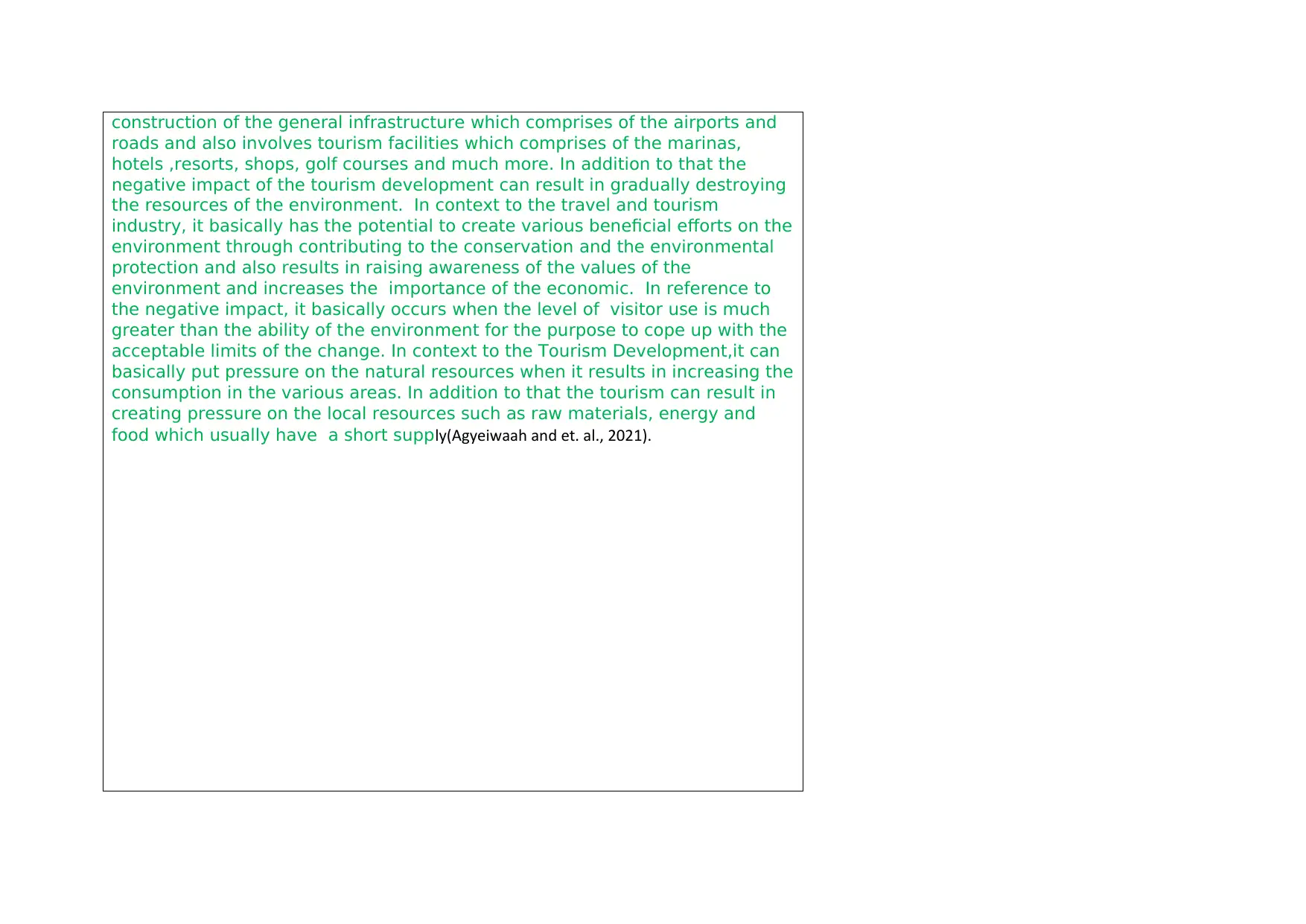
construction of the general infrastructure which comprises of the airports and
roads and also involves tourism facilities which comprises of the marinas,
hotels ,resorts, shops, golf courses and much more. In addition to that the
negative impact of the tourism development can result in gradually destroying
the resources of the environment. In context to the travel and tourism
industry, it basically has the potential to create various beneficial efforts on the
environment through contributing to the conservation and the environmental
protection and also results in raising awareness of the values of the
environment and increases the importance of the economic. In reference to
the negative impact, it basically occurs when the level of visitor use is much
greater than the ability of the environment for the purpose to cope up with the
acceptable limits of the change. In context to the Tourism Development,it can
basically put pressure on the natural resources when it results in increasing the
consumption in the various areas. In addition to that the tourism can result in
creating pressure on the local resources such as raw materials, energy and
food which usually have a short supply(Agyeiwaah and et. al., 2021).
roads and also involves tourism facilities which comprises of the marinas,
hotels ,resorts, shops, golf courses and much more. In addition to that the
negative impact of the tourism development can result in gradually destroying
the resources of the environment. In context to the travel and tourism
industry, it basically has the potential to create various beneficial efforts on the
environment through contributing to the conservation and the environmental
protection and also results in raising awareness of the values of the
environment and increases the importance of the economic. In reference to
the negative impact, it basically occurs when the level of visitor use is much
greater than the ability of the environment for the purpose to cope up with the
acceptable limits of the change. In context to the Tourism Development,it can
basically put pressure on the natural resources when it results in increasing the
consumption in the various areas. In addition to that the tourism can result in
creating pressure on the local resources such as raw materials, energy and
food which usually have a short supply(Agyeiwaah and et. al., 2021).
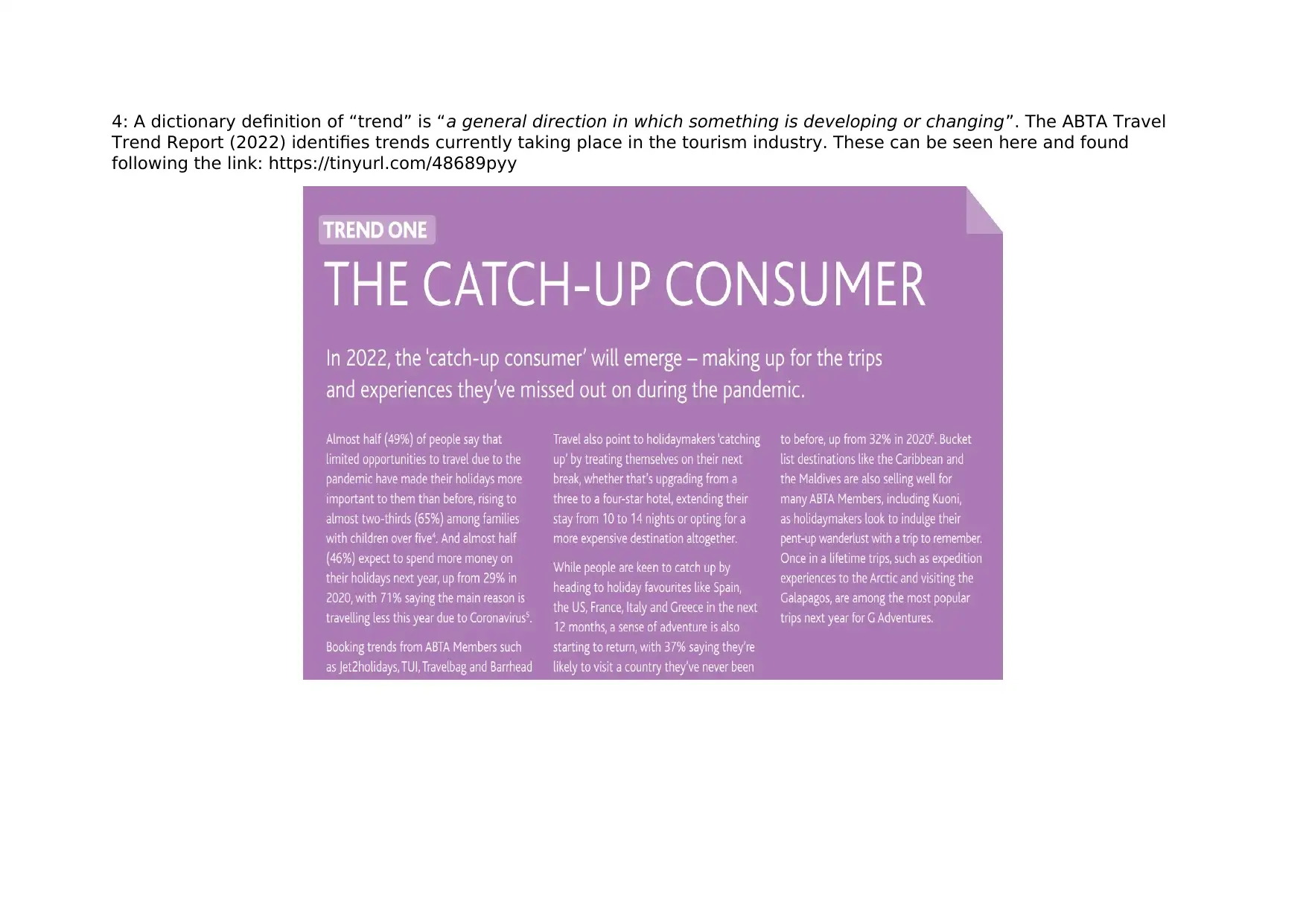
4: A dictionary definition of “trend” is “a general direction in which something is developing or changing”. The ABTA Travel
Trend Report (2022) identifies trends currently taking place in the tourism industry. These can be seen here and found
following the link: https://tinyurl.com/48689pyy
Trend Report (2022) identifies trends currently taking place in the tourism industry. These can be seen here and found
following the link: https://tinyurl.com/48689pyy
Secure Best Marks with AI Grader
Need help grading? Try our AI Grader for instant feedback on your assignments.
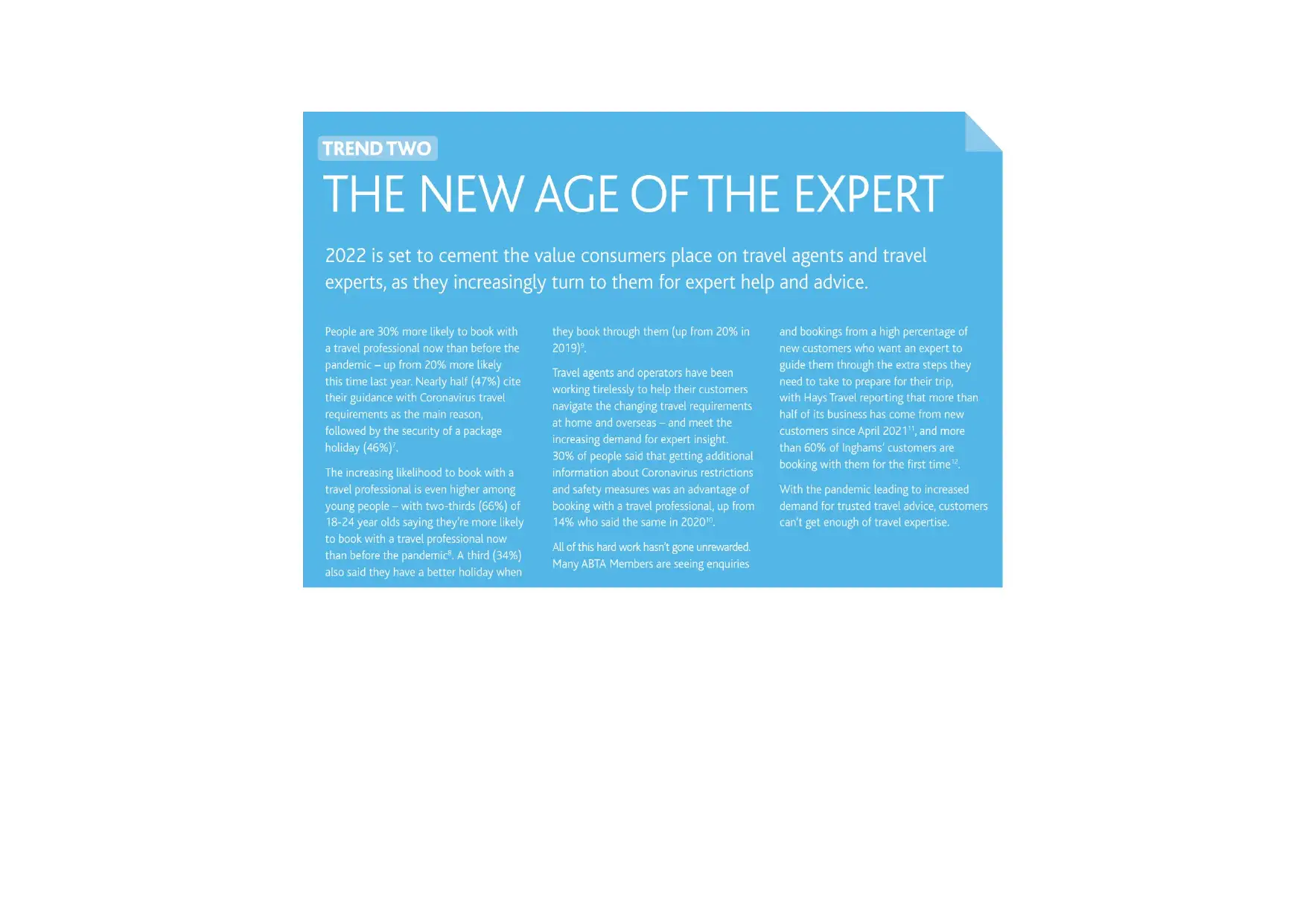
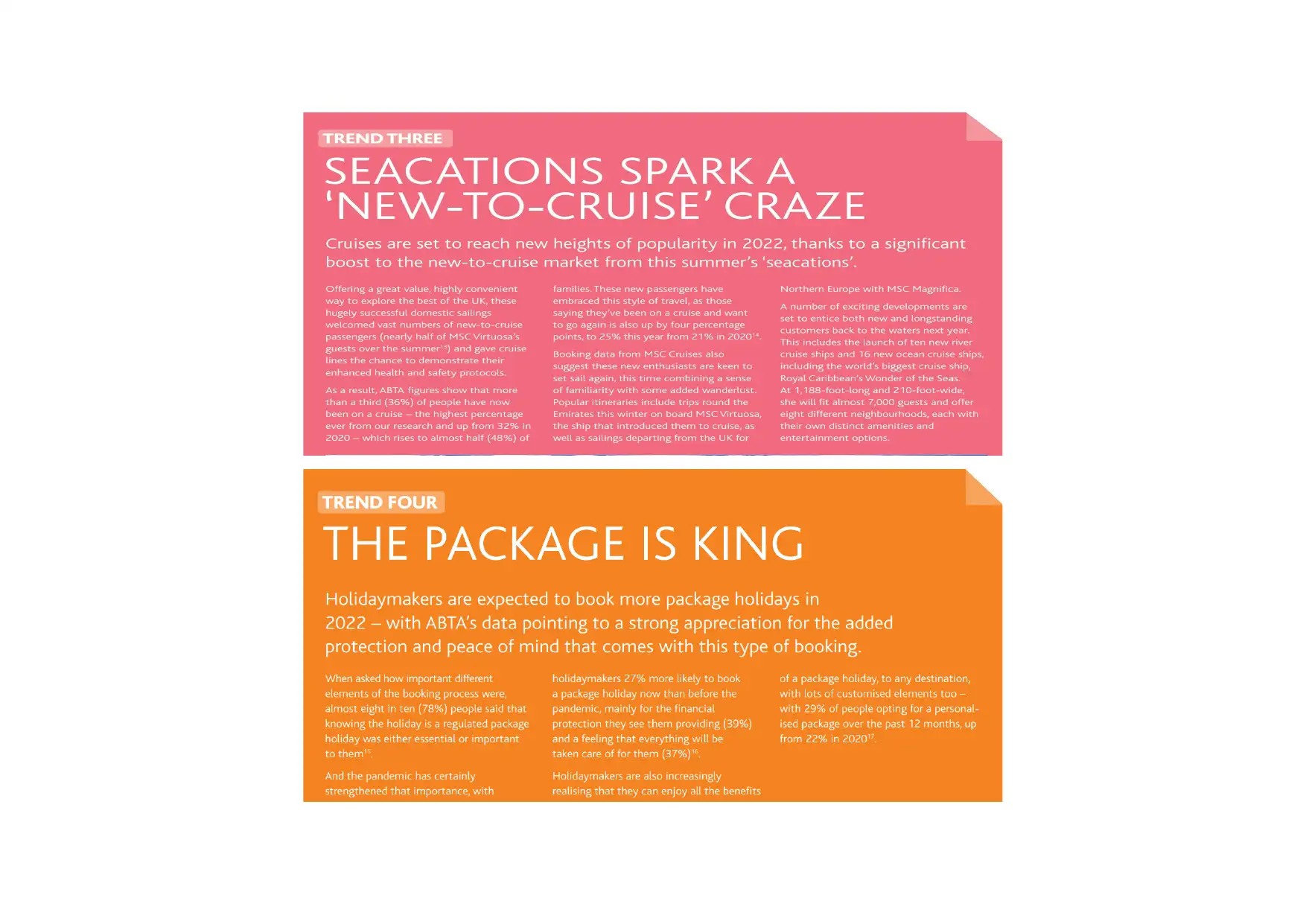
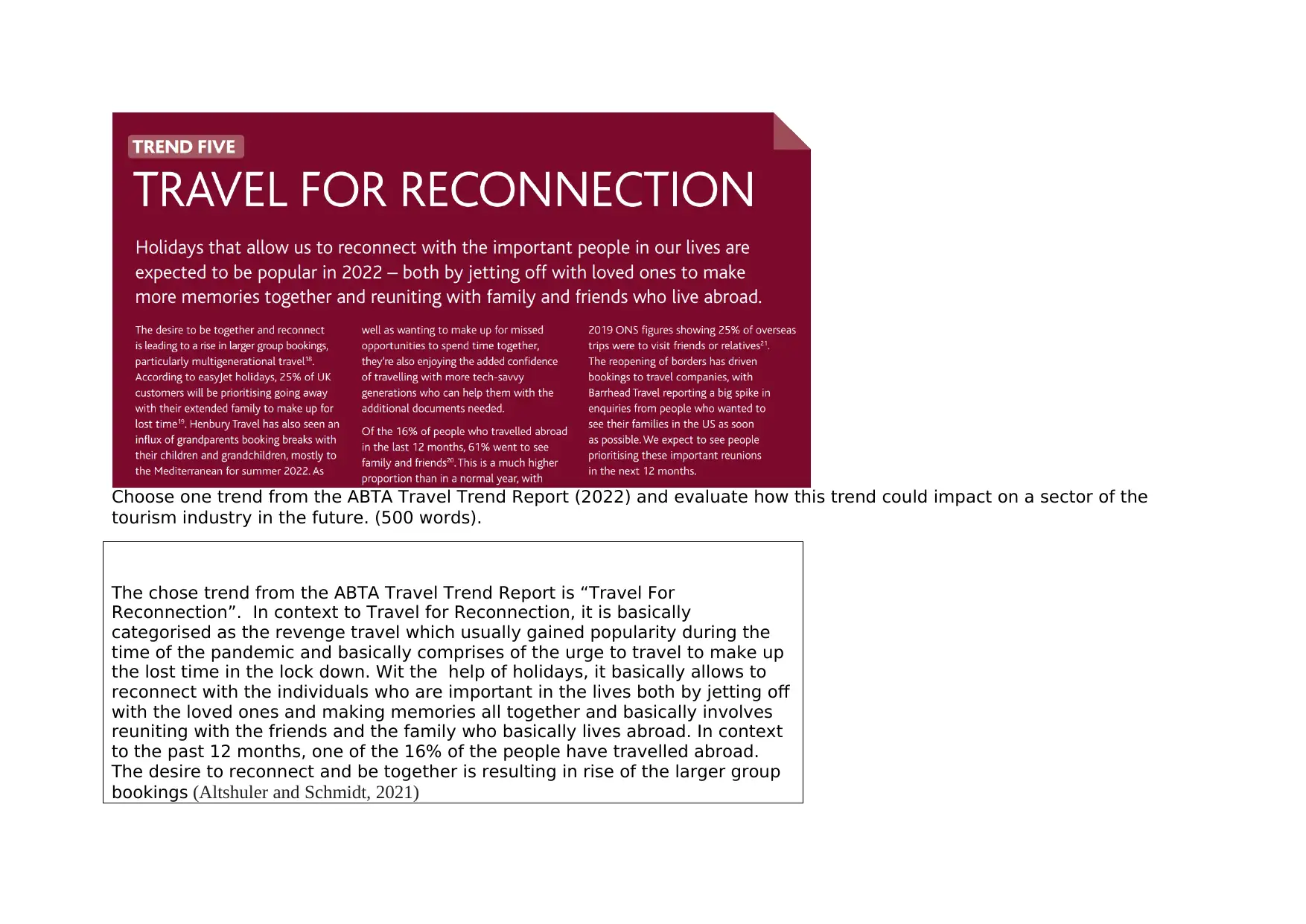
Choose one trend from the ABTA Travel Trend Report (2022) and evaluate how this trend could impact on a sector of the
tourism industry in the future. (500 words).
The chose trend from the ABTA Travel Trend Report is “Travel For
Reconnection”. In context to Travel for Reconnection, it is basically
categorised as the revenge travel which usually gained popularity during the
time of the pandemic and basically comprises of the urge to travel to make up
the lost time in the lock down. Wit the help of holidays, it basically allows to
reconnect with the individuals who are important in the lives both by jetting off
with the loved ones and making memories all together and basically involves
reuniting with the friends and the family who basically lives abroad. In context
to the past 12 months, one of the 16% of the people have travelled abroad.
The desire to reconnect and be together is resulting in rise of the larger group
bookings (Altshuler and Schmidt, 2021)
tourism industry in the future. (500 words).
The chose trend from the ABTA Travel Trend Report is “Travel For
Reconnection”. In context to Travel for Reconnection, it is basically
categorised as the revenge travel which usually gained popularity during the
time of the pandemic and basically comprises of the urge to travel to make up
the lost time in the lock down. Wit the help of holidays, it basically allows to
reconnect with the individuals who are important in the lives both by jetting off
with the loved ones and making memories all together and basically involves
reuniting with the friends and the family who basically lives abroad. In context
to the past 12 months, one of the 16% of the people have travelled abroad.
The desire to reconnect and be together is resulting in rise of the larger group
bookings (Altshuler and Schmidt, 2021)
Paraphrase This Document
Need a fresh take? Get an instant paraphrase of this document with our AI Paraphraser
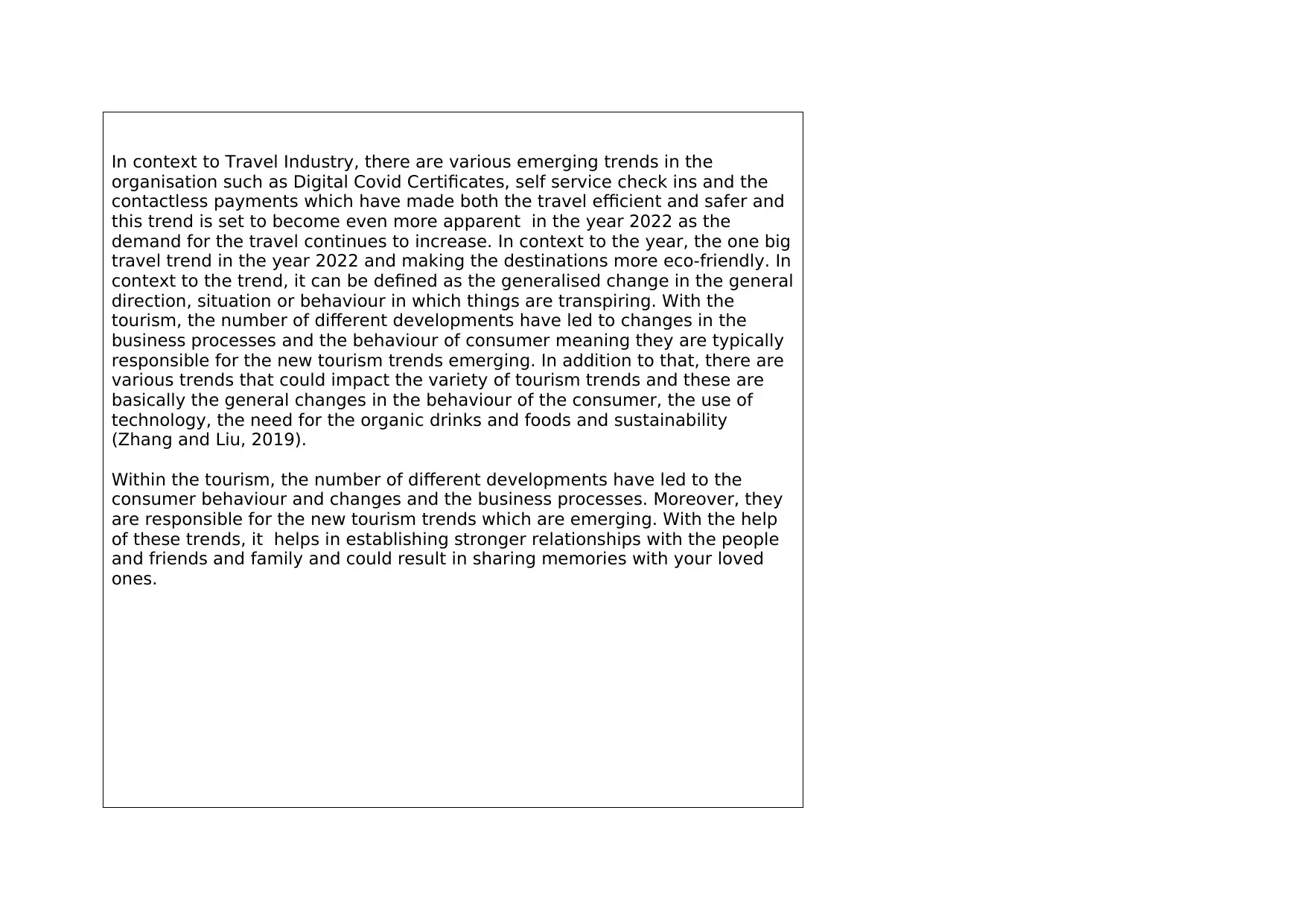
In context to Travel Industry, there are various emerging trends in the
organisation such as Digital Covid Certificates, self service check ins and the
contactless payments which have made both the travel efficient and safer and
this trend is set to become even more apparent in the year 2022 as the
demand for the travel continues to increase. In context to the year, the one big
travel trend in the year 2022 and making the destinations more eco-friendly. In
context to the trend, it can be defined as the generalised change in the general
direction, situation or behaviour in which things are transpiring. With the
tourism, the number of different developments have led to changes in the
business processes and the behaviour of consumer meaning they are typically
responsible for the new tourism trends emerging. In addition to that, there are
various trends that could impact the variety of tourism trends and these are
basically the general changes in the behaviour of the consumer, the use of
technology, the need for the organic drinks and foods and sustainability
(Zhang and Liu, 2019).
Within the tourism, the number of different developments have led to the
consumer behaviour and changes and the business processes. Moreover, they
are responsible for the new tourism trends which are emerging. With the help
of these trends, it helps in establishing stronger relationships with the people
and friends and family and could result in sharing memories with your loved
ones.
organisation such as Digital Covid Certificates, self service check ins and the
contactless payments which have made both the travel efficient and safer and
this trend is set to become even more apparent in the year 2022 as the
demand for the travel continues to increase. In context to the year, the one big
travel trend in the year 2022 and making the destinations more eco-friendly. In
context to the trend, it can be defined as the generalised change in the general
direction, situation or behaviour in which things are transpiring. With the
tourism, the number of different developments have led to changes in the
business processes and the behaviour of consumer meaning they are typically
responsible for the new tourism trends emerging. In addition to that, there are
various trends that could impact the variety of tourism trends and these are
basically the general changes in the behaviour of the consumer, the use of
technology, the need for the organic drinks and foods and sustainability
(Zhang and Liu, 2019).
Within the tourism, the number of different developments have led to the
consumer behaviour and changes and the business processes. Moreover, they
are responsible for the new tourism trends which are emerging. With the help
of these trends, it helps in establishing stronger relationships with the people
and friends and family and could result in sharing memories with your loved
ones.

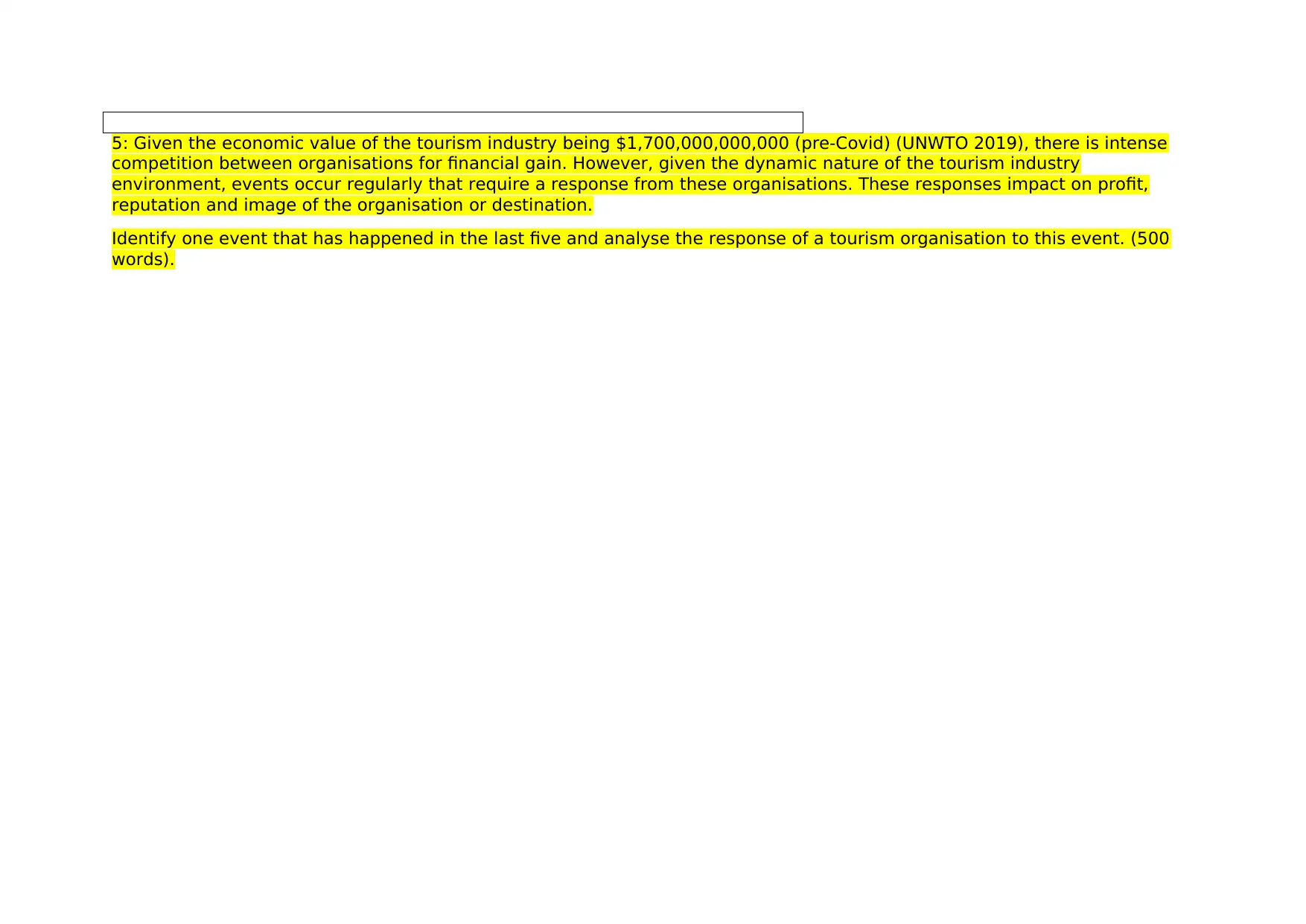
5: Given the economic value of the tourism industry being $1,700,000,000,000 (pre-Covid) (UNWTO 2019), there is intense
competition between organisations for financial gain. However, given the dynamic nature of the tourism industry
environment, events occur regularly that require a response from these organisations. These responses impact on profit,
reputation and image of the organisation or destination.
Identify one event that has happened in the last five and analyse the response of a tourism organisation to this event. (500
words).
competition between organisations for financial gain. However, given the dynamic nature of the tourism industry
environment, events occur regularly that require a response from these organisations. These responses impact on profit,
reputation and image of the organisation or destination.
Identify one event that has happened in the last five and analyse the response of a tourism organisation to this event. (500
words).
Secure Best Marks with AI Grader
Need help grading? Try our AI Grader for instant feedback on your assignments.
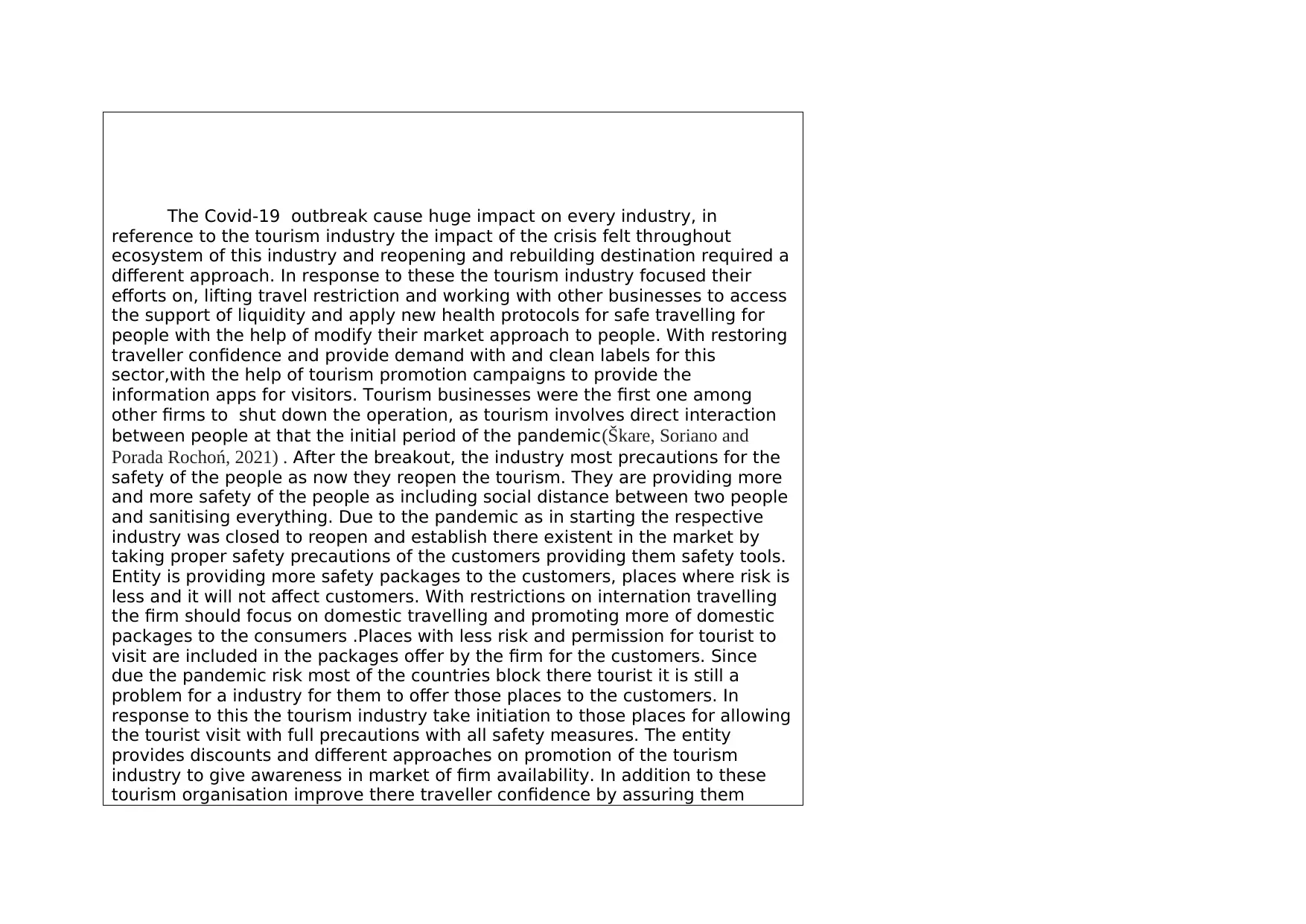
The Covid-19 outbreak cause huge impact on every industry, in
reference to the tourism industry the impact of the crisis felt throughout
ecosystem of this industry and reopening and rebuilding destination required a
different approach. In response to these the tourism industry focused their
efforts on, lifting travel restriction and working with other businesses to access
the support of liquidity and apply new health protocols for safe travelling for
people with the help of modify their market approach to people. With restoring
traveller confidence and provide demand with and clean labels for this
sector,with the help of tourism promotion campaigns to provide the
information apps for visitors. Tourism businesses were the first one among
other firms to shut down the operation, as tourism involves direct interaction
between people at that the initial period of the pandemic(Škare, Soriano and
Porada Rochoń, 2021) . After the breakout, the industry most precautions for the
safety of the people as now they reopen the tourism. They are providing more
and more safety of the people as including social distance between two people
and sanitising everything. Due to the pandemic as in starting the respective
industry was closed to reopen and establish there existent in the market by
taking proper safety precautions of the customers providing them safety tools.
Entity is providing more safety packages to the customers, places where risk is
less and it will not affect customers. With restrictions on internation travelling
the firm should focus on domestic travelling and promoting more of domestic
packages to the consumers .Places with less risk and permission for tourist to
visit are included in the packages offer by the firm for the customers. Since
due the pandemic risk most of the countries block there tourist it is still a
problem for a industry for them to offer those places to the customers. In
response to this the tourism industry take initiation to those places for allowing
the tourist visit with full precautions with all safety measures. The entity
provides discounts and different approaches on promotion of the tourism
industry to give awareness in market of firm availability. In addition to these
tourism organisation improve there traveller confidence by assuring them
reference to the tourism industry the impact of the crisis felt throughout
ecosystem of this industry and reopening and rebuilding destination required a
different approach. In response to these the tourism industry focused their
efforts on, lifting travel restriction and working with other businesses to access
the support of liquidity and apply new health protocols for safe travelling for
people with the help of modify their market approach to people. With restoring
traveller confidence and provide demand with and clean labels for this
sector,with the help of tourism promotion campaigns to provide the
information apps for visitors. Tourism businesses were the first one among
other firms to shut down the operation, as tourism involves direct interaction
between people at that the initial period of the pandemic(Škare, Soriano and
Porada Rochoń, 2021) . After the breakout, the industry most precautions for the
safety of the people as now they reopen the tourism. They are providing more
and more safety of the people as including social distance between two people
and sanitising everything. Due to the pandemic as in starting the respective
industry was closed to reopen and establish there existent in the market by
taking proper safety precautions of the customers providing them safety tools.
Entity is providing more safety packages to the customers, places where risk is
less and it will not affect customers. With restrictions on internation travelling
the firm should focus on domestic travelling and promoting more of domestic
packages to the consumers .Places with less risk and permission for tourist to
visit are included in the packages offer by the firm for the customers. Since
due the pandemic risk most of the countries block there tourist it is still a
problem for a industry for them to offer those places to the customers. In
response to this the tourism industry take initiation to those places for allowing
the tourist visit with full precautions with all safety measures. The entity
provides discounts and different approaches on promotion of the tourism
industry to give awareness in market of firm availability. In addition to these
tourism organisation improve there traveller confidence by assuring them
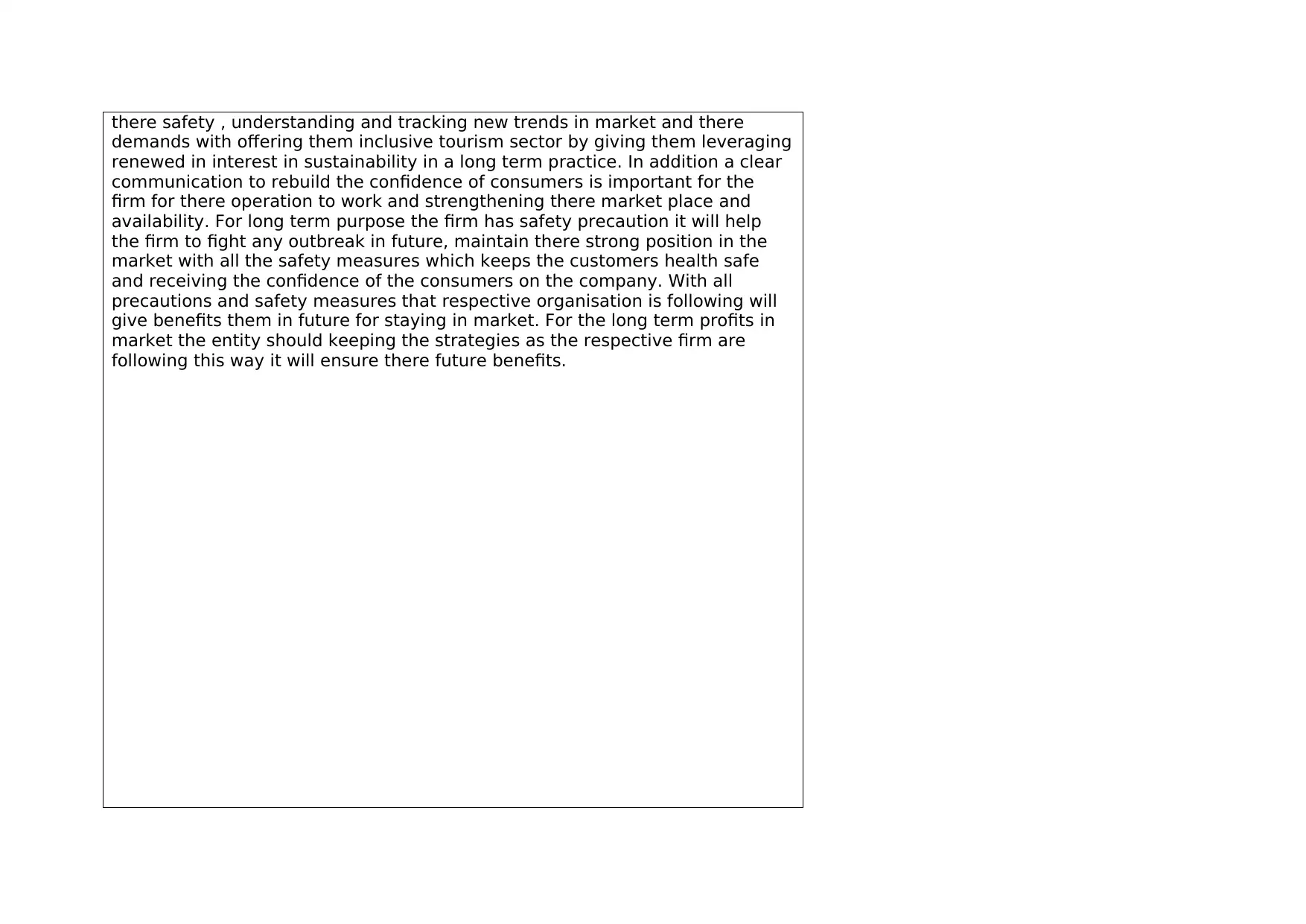
there safety , understanding and tracking new trends in market and there
demands with offering them inclusive tourism sector by giving them leveraging
renewed in interest in sustainability in a long term practice. In addition a clear
communication to rebuild the confidence of consumers is important for the
firm for there operation to work and strengthening there market place and
availability. For long term purpose the firm has safety precaution it will help
the firm to fight any outbreak in future, maintain there strong position in the
market with all the safety measures which keeps the customers health safe
and receiving the confidence of the consumers on the company. With all
precautions and safety measures that respective organisation is following will
give benefits them in future for staying in market. For the long term profits in
market the entity should keeping the strategies as the respective firm are
following this way it will ensure there future benefits.
demands with offering them inclusive tourism sector by giving them leveraging
renewed in interest in sustainability in a long term practice. In addition a clear
communication to rebuild the confidence of consumers is important for the
firm for there operation to work and strengthening there market place and
availability. For long term purpose the firm has safety precaution it will help
the firm to fight any outbreak in future, maintain there strong position in the
market with all the safety measures which keeps the customers health safe
and receiving the confidence of the consumers on the company. With all
precautions and safety measures that respective organisation is following will
give benefits them in future for staying in market. For the long term profits in
market the entity should keeping the strategies as the respective firm are
following this way it will ensure there future benefits.
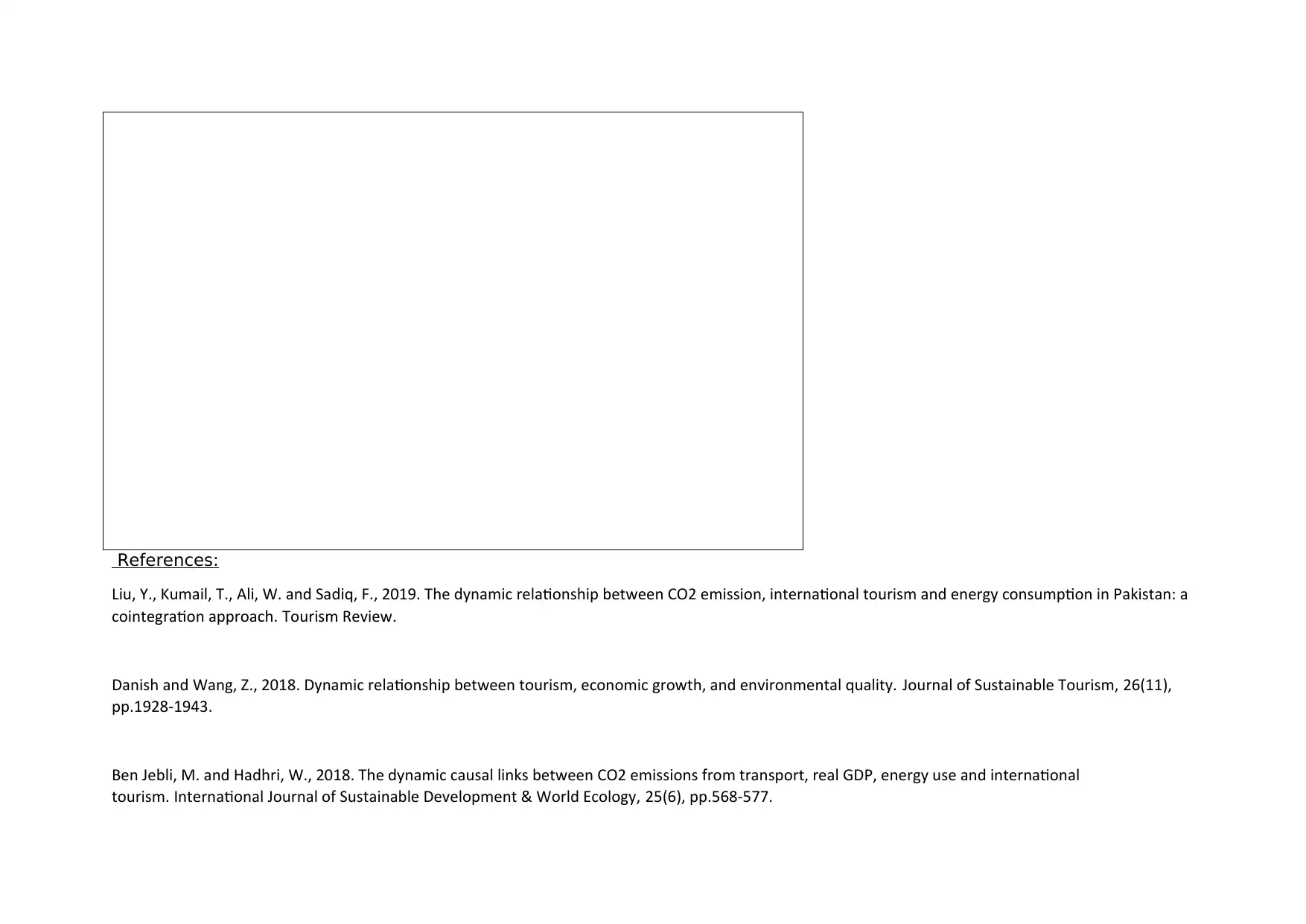
References:
Liu, Y., Kumail, T., Ali, W. and Sadiq, F., 2019. The dynamic relationship between CO2 emission, international tourism and energy consumption in Pakistan: a
cointegration approach. Tourism Review.
Danish and Wang, Z., 2018. Dynamic relationship between tourism, economic growth, and environmental quality. Journal of Sustainable Tourism, 26(11),
pp.1928-1943.
Ben Jebli, M. and Hadhri, W., 2018. The dynamic causal links between CO2 emissions from transport, real GDP, energy use and international
tourism. International Journal of Sustainable Development & World Ecology, 25(6), pp.568-577.
Liu, Y., Kumail, T., Ali, W. and Sadiq, F., 2019. The dynamic relationship between CO2 emission, international tourism and energy consumption in Pakistan: a
cointegration approach. Tourism Review.
Danish and Wang, Z., 2018. Dynamic relationship between tourism, economic growth, and environmental quality. Journal of Sustainable Tourism, 26(11),
pp.1928-1943.
Ben Jebli, M. and Hadhri, W., 2018. The dynamic causal links between CO2 emissions from transport, real GDP, energy use and international
tourism. International Journal of Sustainable Development & World Ecology, 25(6), pp.568-577.
Paraphrase This Document
Need a fresh take? Get an instant paraphrase of this document with our AI Paraphraser
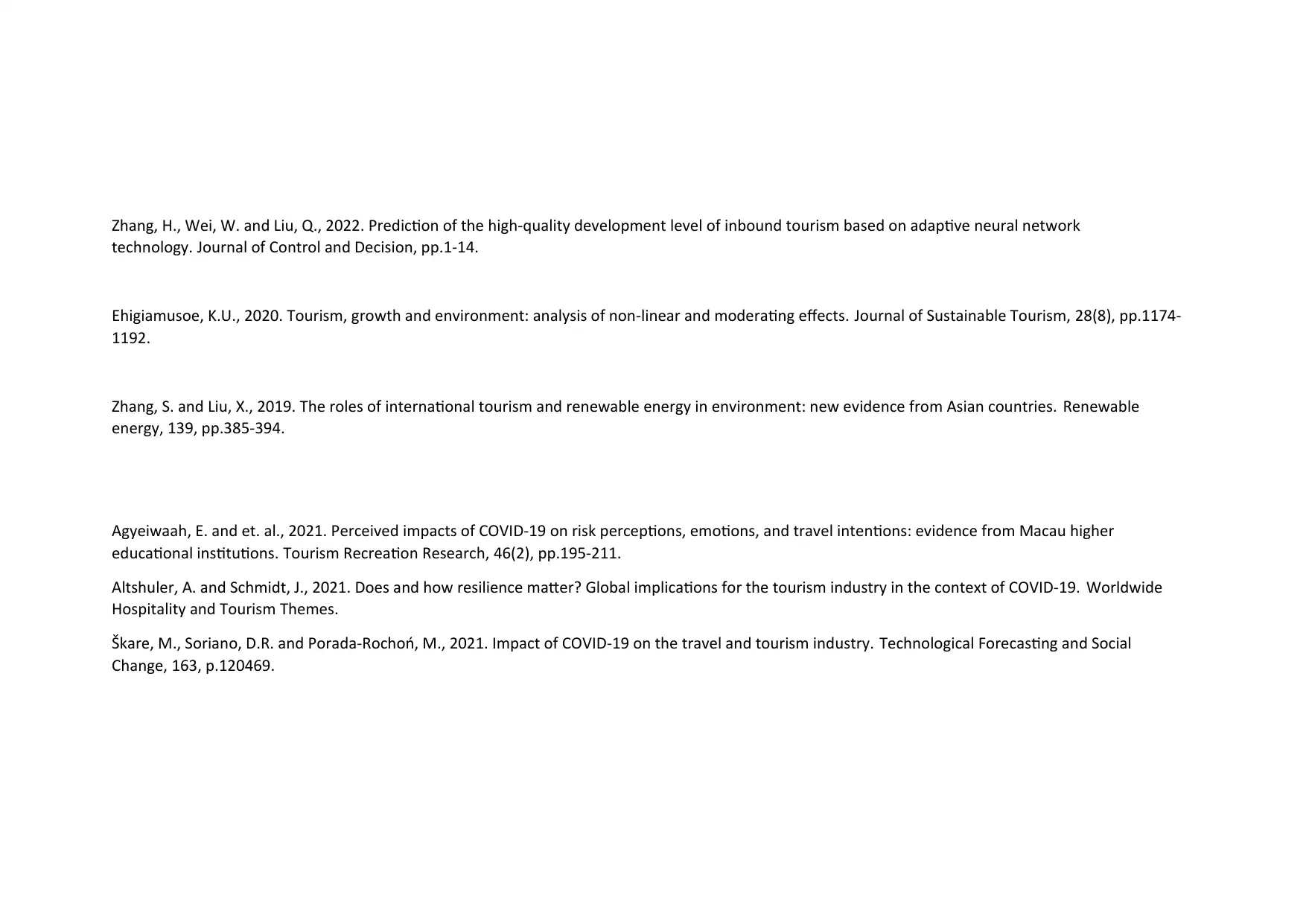
Zhang, H., Wei, W. and Liu, Q., 2022. Prediction of the high-quality development level of inbound tourism based on adaptive neural network
technology. Journal of Control and Decision, pp.1-14.
Ehigiamusoe, K.U., 2020. Tourism, growth and environment: analysis of non-linear and moderating effects. Journal of Sustainable Tourism, 28(8), pp.1174-
1192.
Zhang, S. and Liu, X., 2019. The roles of international tourism and renewable energy in environment: new evidence from Asian countries. Renewable
energy, 139, pp.385-394.
Agyeiwaah, E. and et. al., 2021. Perceived impacts of COVID-19 on risk perceptions, emotions, and travel intentions: evidence from Macau higher
educational institutions. Tourism Recreation Research, 46(2), pp.195-211.
Altshuler, A. and Schmidt, J., 2021. Does and how resilience matter? Global implications for the tourism industry in the context of COVID-19. Worldwide
Hospitality and Tourism Themes.
Škare, M., Soriano, D.R. and Porada-Rochoń, M., 2021. Impact of COVID-19 on the travel and tourism industry. Technological Forecasting and Social
Change, 163, p.120469.
technology. Journal of Control and Decision, pp.1-14.
Ehigiamusoe, K.U., 2020. Tourism, growth and environment: analysis of non-linear and moderating effects. Journal of Sustainable Tourism, 28(8), pp.1174-
1192.
Zhang, S. and Liu, X., 2019. The roles of international tourism and renewable energy in environment: new evidence from Asian countries. Renewable
energy, 139, pp.385-394.
Agyeiwaah, E. and et. al., 2021. Perceived impacts of COVID-19 on risk perceptions, emotions, and travel intentions: evidence from Macau higher
educational institutions. Tourism Recreation Research, 46(2), pp.195-211.
Altshuler, A. and Schmidt, J., 2021. Does and how resilience matter? Global implications for the tourism industry in the context of COVID-19. Worldwide
Hospitality and Tourism Themes.
Škare, M., Soriano, D.R. and Porada-Rochoń, M., 2021. Impact of COVID-19 on the travel and tourism industry. Technological Forecasting and Social
Change, 163, p.120469.

1 out of 21
Related Documents
Your All-in-One AI-Powered Toolkit for Academic Success.
+13062052269
info@desklib.com
Available 24*7 on WhatsApp / Email
![[object Object]](/_next/static/media/star-bottom.7253800d.svg)
Unlock your academic potential
© 2024 | Zucol Services PVT LTD | All rights reserved.


